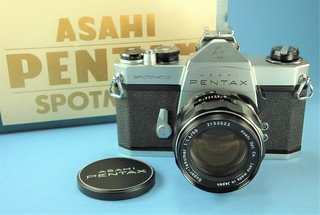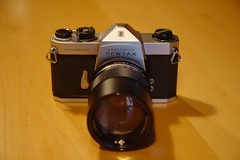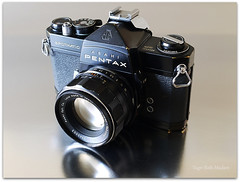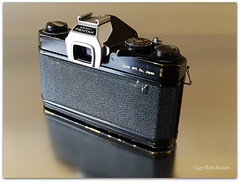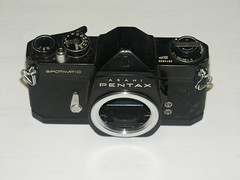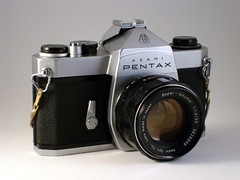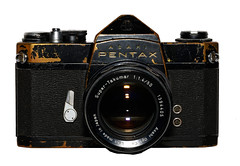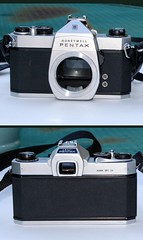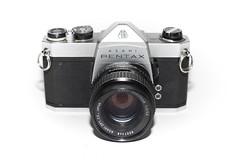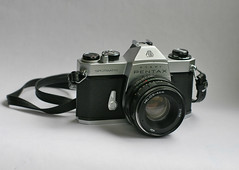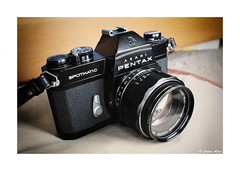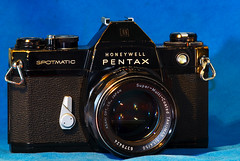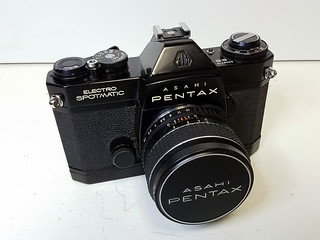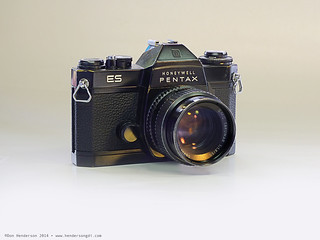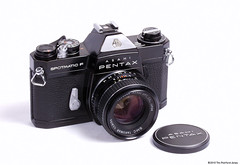Pentax Spotmatic
| ||
|
The Asahi Pentax Spotmatic is one of the early successful Japanese cameras, with over 4 million sold between 1960 and 1977. The Spotmatics are well known for bringing stop-down Through-the-Lens (TTL) metering to the masses, with a light metering system that was easy to use, intuitive and affordable, becoming favorite SLR of enthusiasts and professionals at the time.
Asahi Optical Company (later Pentax), presented the original prototype called Spot-Matic in Photokina 1960 designed by a team lead by Dr. Minoru Suzuki's with a spot-metering system; by the time sales began in 1964, coinciding with the Olympics in Tokyo, the metering system was an average metering. These cameras use the M42x1mm lens mount, just like their predecessor (Pentax S/H series) which allowed them to use a large amount of lenses from many manufacturers.
Asahi Optical set new standards in quality of image and construction under the Takumar brand, and the late models called Super-Multi-Coated Takumar allowed for fully opened light-metering with mechanical linkage to the camera which was used in the Spotmatic F and the Electro Spotmatics. Asahi Optical introduced a large number of Takumar lenses, of excellent construction and image quality, and which were improved over time with high quality coating, setting the standards for years to come, some have achieved cult-like status.
The Spotmatics were in production for a long time, and improvements were made continuously both mechanically and in electronics, resulting in several models, and over 5 million cameras sold, until they were finally replaced by the K-series of cameras in 1975. The original "Spot-matic" was presented in Photokina 1960 (sales began 1964) and is one of the first (if not the first) cameras with Through-the-Lens (TTL) metering; the Spotmatic II added a hot shoe, and later with the evolution and miniaturization of electronics an electronic camera with aperture priority was introuced, the Electro Spotmatic (ES), finally the Spotmatic F introduced fully opened light metering.
Introduction
Asahi Optical Company introduced the Spot-Matic prototype in Photokina 1960,[1] this camera was revolutionary with a light measuring system located in a small arm in the center of the viewing area, effectively metering light as a spot-meter. This design was used several years later, as technology advanced, in cameras such as the Leica CL and Leica M5. However at the time limitation in technology made it impractical and the Asahi staff looked for other solutions.[2]
The Spotmatic camera was launched to the public in 1964, by that time the metering system had been changed to average-metering by using 2 small CdS cells, one on each side of the viewfinder covering the whole picture area. A switch on the side of the mirror houseing activates the light meter and a needle shows the exposure to be correct. This light metering system was very succesful and it was adopted by many other camera companies.
The change in the metering system was not reflected in the marketing materials, and the original name continued to be used. Focusing is relatively easy, the finder is bright corner to corner by the use of a fresnel lens and a "microgrid" at the center of the image fractures the image when not in focus.[3]
The Spotmatic was not an evolution of the previous Asahi Pentax cameras, but a completely new design inside and out. Camera body and mirror box are made of aluminum, the mirror mechanism was improved, and more importantly the shutter had a new design. In the new design the life cycle in increased from 20,000 to 100,000 and the flash synchronization is 1/60 instead of 1/50. Focusing screen design allowed for a brighter viewfinder that was easier to focus. Film transport guide rails were broadened and the pressure plate elongated to keep the film flatter. Self-timer mechanisms was redesigned as well.[2] Over the course of the production of the Spotmatic, over 100 internal changes were made to the camera, like improved focusing screens (microgrid in the later versions is finer and more precise), more reliable mirror mechanism, changes to the light meter switch, etc.
Asahi assembled a very complete system of photography with a large set of accessories to choose from, including cases, macro accessories, filters, copying units (Repronar), etc. Special models such as the SP Motor Drive, Data back were also available and several variations exist.
Models
During the production of the Spotmatic (1964-1977) and as technology and electronics advanced, a series of different models were made. Within each model relatively long production run minor changes and improvements were made from early to late units of the same model.
In the United States, Asahi Optical had an agreement first with Heiland, and then with Honeywell, and cameras were imported and marketed by Honeywell and for the Spotmatic series, no change of name happened as it had before. In the US cameras were badged Honeywell Spotmatic , while in the rest of the world they were Asahi Spotmatic.
The Spotmatic SP
The Spotmatic SP was introduced by Asahi Optical Company in 1964, after being presented as Spot-Matic in Photokina 1960, and was one of the first 35mm SLR cameras with through-the-lens light metering. While Topcon might have introduced TTL metering first, the solution found by Asahi Pentax was accepted more by consumers, and this camera became the best seller of the time.
The light metering system provided average-metering by using 2 small CdS cells, one on each side of the viewfinder covering the whole picture area. A small switch on the (photographer's) left side of the lens housing was pushed up to stop down the lens and activate the meter; the exposure controls would then be adjusted to center a needle on the right edge of the viewfinder.
The light meter, was powered by a 1.35 volt PX400 mercury cell. Mercury batteries are now banned but Zinc-Air batteries can be used instead, or it is possible to carry out a minor modification to the meter circuit to allow the use of 1.55 volt 387S silver-oxide batteries. Later versions of the camera can use silver-oxide batteries without any modification.
The camera in made in Aluminum, compared to the previous versions that had a mirror box made in bronze, and its streamlined design became the template for many other SLRs. The shutter is mechanical, with speeds from 1 to 1/1000 and flash sync speed at 1/60s. The Spotmatic SP did not have a hot-shoe but an accessory cold-shoe and front connector for FP and X synchronization. Focusing screen is a fresnel type microprism with a central microgrid with 0,85x magnification, and with the 55mm f/1.8 lens the camera could be used with both eyes open for sports.[2][3] This viewfinder was very bright for its time.
The Spotmatic continued the use of lenses with an M42 screw thread as its predecessors, providing a large range of available lenses from many manufacturers. Asahi Optical introduced the Super Takumar lenses as companion of the Spotmatic line, and raised the bar of quality for years to come. The system became the workhorse of many professionals of the period.
Three variants of the Spotmatic SP are common:
1) Black and chrome body with Asahi Pentax badge on prism housing, Spotmatic badge on front below shutter release and SP badge on top near the rewind knob.
2) All black body with Asahi Pentax badge on prism housing, Spotmatic badge on front below shutter release and SP badge on top near the rewind knob.
3) Blank and chrome body with Honeywell Pentax badge on prism housing and Spotmatic badge on front below shutter release (but no SP badge).
Specifications
- Type: SLR body
- Manufacturer: Asahi Optical Co.
- Year of launch: 1964
- Film: 35mm, early models had speed range 10-800 ASA and after 1965 20-1600 ASA
- Viewfinder: pentaprism eye-level viewfinder 0.88x magnification with 50mm and life-size with 55mm (allows shooting with both eyes open)
- Lens Mount: Pentax/Praktica screwmount (M42x1mm)
- Shutter: Focal plane shutter, speeds 1 - 1/1000 second, flash sync 1/60 second
- Metering: CdS TTL average metering (stopped-down manual match-needle metering system) EV 3~18 (ISO 100) early models and 1.7 ~ 18 (ISO 100) later models.
- Flash: FP or X
- Dimensions 143 x 92 x 50 mm (5,6x3.6x2")
- Weight: 610-621g (1lb 6oz) without lens.
- Product number: 231; 23100 (from 10/1966); 23102; 23104
|
|
| |||||||||
|
|
|
|
The SL
The Pentax SL (Product Nr.23105) was introduced in 1968 as a replacement for the SV/H3v, is basically a Spotmatic except that it does not include built-in light metering. The bottom plate doesn't have a battery compartment and is thus lighter than the SP.
A CdS clip-on exposure meter could be bought as accessory and is not compatible with the previous model's clip-on
Like the SP, it came in 3 variants, black and chrome Asahi, black Asahi, black and chrome Honeywell.
Specifications
Same as SP
- Weight: 580-600g (1lb 6oz) without lens.
- Product number: 23105
|
|
|
The SP500 and SP1000
While the Spotmatics were evolving, Asahi maintained a line of cameras which was identical to the original Spotmatic, as entry-level models, calling them SP500 and SP1000 depending on the max speed in the dial. These cameras are virtually identical to the Spotmatic SP except there is no self timer and they were offered with a Super-Takumar or SMC 55mm f/2, the SP500 and SP1000 were not for sale in Japan. Many were assembled in Hong Kong.
The SP500 was introduced after the SPII in 1971 (Product Nr.23109) and SP1000 introduced after the SP-F in 1974 (Product Nr. 23120). The SP500 shutter speed dial shows a max speed of 1/500, like the SP1000 and SP the SP500 can actually shoot at 1/1000 by turning the shutter speed dial to an unmarked stop after 1/500.
Like the SP, the SP500/SP1000 models came in 2 variants, black and chrome Asahi, and black and chrome Honeywell.
Specifications
Same as SP
- Dimensions 143 x 92 x 50 mm (5,6x3.6x2")
- Weight: 600g without lens.
- Product number: 23109 (SP500); 23120 (SP1000)
|
|
|
The Spotmatic SP II
An updated version of the original Spotmatic SP, launched in 1971 under Product Nr.23108. As well as a number of minor improvements to the meter components and film transport, the SP II was fitted with a hot shoe with a switch under the rewind crank for FP and X-flash synchronization and the ASA range was increased to 3200.
More importantly, at the same time the Super Multi Coated Takumar lenses were launched, with 7 layer coating which improved image quality and contrast, and mechanical pins for the aperture reading.
Specifications
- Type: SLR body
- Manufacturer: Asahi Optical Co.
- Year of launch: 1971
- Film: 35mm, 20-3200 ASA
- Viewfinder: pentaprism eye-level viewfinder 0.88x magnification with 50mm and life-size with 55mm (allows shooting with both eyes open)
- Lens Mount: Pentax/Praktica screwmount (M42x1mm)
- Shutter: Focal plane shutter, speeds 1 - 1/1000 second, flash sync 1/60 second
- Metering: CdS TTL average metering (stopped-down manual match-needle metering system) EV 3~18 (ISO 100) early models and 1.7 ~ 18 (ISO 100) later models.
- Flash: FP or X
- Dimensions 143 x 92 x 50 mm (5,6x3.6x2")
- Weight: 625g (1lb 7oz) without lens.
- Product number: 23108
|
|
The Spotmatic SP IIa
Virtually identical to the SP II, it had an "electronic eye" introduced to support the Honeywell Strobonar line of dedicated flashes 772 and 882. The sensor was set to 3 different apertures for exposures. It was only available in the North American market, in chrome or black with the Honeywell badge as Product Nr. 23112.
Specifications
Same as SPII
- Weight: 640g (1lb 8oz) without lens.
- Product number: 23112
|
|
The ES or Electro-Spotmatic
Launched in 1971, with Product Nr.23111 An electronic shutter was developed for this camera, with speeds between 8s and 1/1000 (even though the camera only says 1-1000) in automatic exposure (aperture priority) and manual speeds of 1/60 - 1/1000 seconds. The light meter operates only when the shutter button is pressed and only in auto mode and the meter needle now indicates the auto shutter speed. The first Pentax SLR with open-aperture metering when using S-M-C and SMC Takumar lenses. This camera is powered by one 4SR44 6.2v silver oxide battery and there is a battery check button. It was available in Chrome and Black
|
|
The Spotmatic SP F
The Spotmatic SP F (Product Nr 23110), launched in 1973, was the first match-needle Spotmatic to offer open-aperture light metering, using the the updated Super-Multi-Coated (S-M-C) Takumar lenses with an aperture-position linkage to the camera.
The light meter was modified by the addition of a 3rd cell, which acts as a switch when there is no light. The meter is constantly on but there when the light is at EV2 or less it switches off, so it is important to keep the lens cap on when the camera is not in use, in order to conserve the battery. The battery now needed extra capacity and was changed to the now-defunct PX625 mercury cell, but since the meter circuit design was revised to take account of the lens aperture setting and to indicate correct exposure when zero current is flowing through the meter, it allows for a variation in voltage from the battery and modern (Silver oxide) batteries can be used.
Besides the light metering changes, a shutter lock was added and the FP option for the hot shoe synchronization was dropped
Specifications
- Type: SLR body
- Manufacturer: Asahi Optical Co.
- Year of launch: 1975
- Film: 35mm, 20-3200 ASA
- Viewfinder: pentaprism eye-level viewfinder 0.88x magnification with 50mm and life-size with 55mm (allows shooting with both eyes open)
- Lens Mount: Pentax/Praktica screwmount (M42x1mm)
- Shutter: Focal plane shutter, speeds 1 - 1/1000 second, flash sync 1/60 second
- Metering: CdS TTL average metering EV 1 ~ 20 (ISO 100) later models.
- Flash: X only
- Dimensions 143 x 93 x 50 mm (5,6x3.6x2")
- Weight: 640g (1lb 8oz) without lens.
- Product number: 23110
|
|||
|
The ES II
The ESII came in 1973, Product Nr. 23117 as an evolution to the ES. Improvements included a self timer, shutter release lock (providing a T-mode in Bulb), interior viewfinder blinds, exposure compensation and shutter speeds from 8 seconds to 1/1000th second in auto mode. The power supply is now four modern 1.5v alkaline or silver oxide cells. It was available in chrome and black versions, and a special MD version was available.
|
Special Models
Several special models were developed from the Spotmatics, such as:
- Pentax Spotmatic MD (Motor Drive)
- Pentax Spotmatic Data I and II(Data back)
Notes
Over the years Spotmatics have become a cult camera, and a good value for money.
Spotmatic cameras SPII and SP1000 remained in production until 1977, even as the line of cameras with K-mount (K2-KX-KM) was being produced.
A few notes on maintenance: -Battery: These cameras were made to use now banned mercury batteries (1.35V), and a few options exist:
- Wein-cells MRB400 This is a zinc air battery that has the precise voltage but has a short life . Zinc-Air batteries for hearing aids could also be used.
- CRIS camera adapter to use Silver oxide batteries which has electronics to adjust the voltage
- However the basic Spotmatic (SP, SP2, SP2A, SP500, SP1000) uses a "bridge" circuit in its meter, making it insensitive to battery voltage variations. It can use Silver-Oxide batteries such as Mallory PX-400 or RM-400-R, Varta V394, Maxell SR936W or SR936SW, Renata 394, or any type 392 equivalent.
- Spotmatic F had a different circuit and a small modification needs to be done to use SilverOxide batteries (SR44/357/AG13)
References
- ↑ When Popular Photography reviewed Photokina 1960, they included the 'Spot-Matic' as one of the highlights. (Vol. 48, No.1; pg. 46).
- ↑ 2.0 2.1 2.2 Gerjan van Oosten. 2021. The definitive Asahi Pentax Collector's Guide. 2nd ed. p.50
- ↑ 3.0 3.1 Keppler Herbert. 1974 The Pentax Way. 8ed. Focal Press, London
Links
- Repair Notes on the Spotmatic
- Manual Camera User's Opinion about the Spotmatic
- Manual Camera User's Opinion about the Spotmatic F
- Spotmatic at Karen Nakamura's Photoethnography.com
- User's manuals at Pentax Website:
- Manuals of Spotmatic and Spotmatic II at Orphan Cameras (Mike Butkus' site)
- Manuals at Pentax Manuals by Kim Coxon
- Spotmatic, SP500, SP1000 on www.collection-appareils.fr by Sylvain Halgand (in French)
- Flickr set by steevithak: Photos of and with the Honeywell Pentax Spotmatic SP
- Pentax Repair Manuals including the Spotmatics at Learn Camera Repair Site

